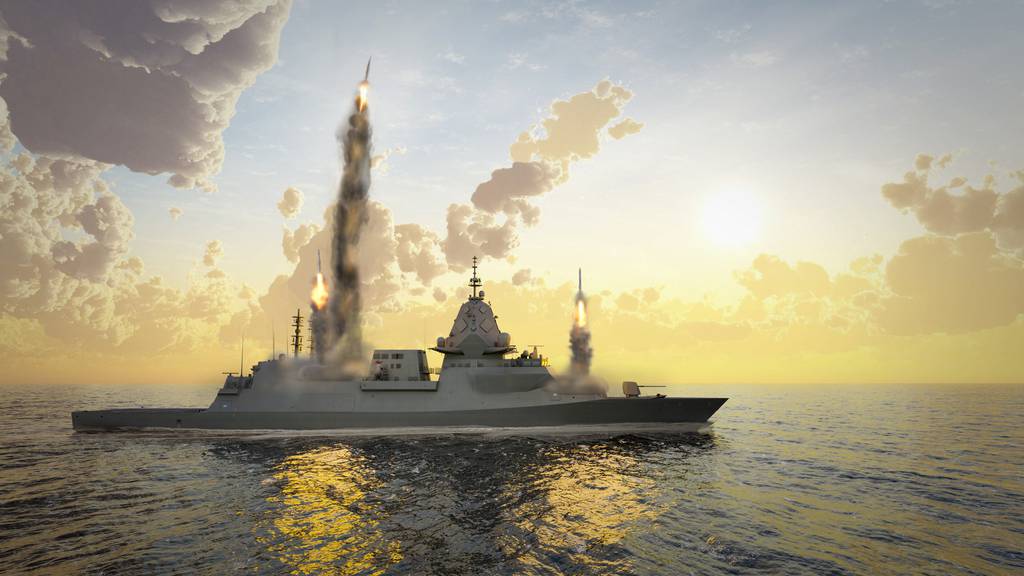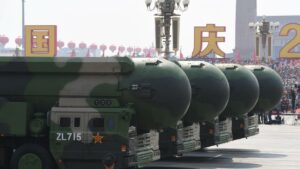
MELBOURNE, Australia — The shipbuilder for a $30 billion Australian program is pushing back against criticism over the design and capabilities of the anti-submarine warfare frigate.
Analysts have lambasted the program, citing the frigate design’s weight growth, scheduling delays and what they view as an inadequate number of vertical launching system cells. Furthermore, in May, Australia’s auditor general slammed the acquisition process in an Australian National Audit Office report, citing serious flaws.
The first phase of the Sea 5000 program involves the production of the ships for the Royal Australian Navy. The government of Prime Minister Anthony Albanese received an independent study of the planned surface fleet on Sept. 29, but its findings will not be made public until the end of the first quarter of 2024.
Former U.S. Navy Vice Adm. William Hilarides conducted the study following recommendations in Australia’s most recent Defence Strategic Review, which called for an enhanced, long-range strike capability, among other things.
But in the meantime, BAE Systems Australia’s managing director for maritime business has pushed back against critics, telling reporters at the Indo Pacific International Maritime Exposition in November that the future frigate recently completed its preliminary design review.
“It still meets all of [Australia’s] key 23 performance criteria [for] speed, range, endurance, seakeeping [and] underwater radiated noise, so I would challenge you to determine why it is still referred to as too heavy and too slow,” Craig Lockhart said. “In fact, it’s still [capable of] 27 knots-plus. And when we get the first ship in the water and get upwards of 31 or 32 knots in the real testing trials, then it will become our model benchmark.”
Design changes
Under the current plan, Australia is seeking to build nine frigates based on the British Type 26 Global Combat Ship design, but featuring an indigenous phased array radar from CEA Technologies and a Saab Australia-made 9LV combat system.
The Australian government chose this modified design, known as the Hunter class, in 2018. BAE Systems Australia is the prime contractor for the Hunter-class frigate program, having beat out Italian firm Fincantieri’s FREMM pitch and Spanish shipbuilder Navantia’s offering of a modified F100 variant.
BAE is currently completing a series of prototyping activities at a purposely designed shipyard in Osborne, South Australia.
The changes to the baseline Type 26 design have resulted in a reduced design margin in terms of weight; the vessel will now displace almost 10,000 tons — an increase over the originally planned 8,800 tons. This is what drove analysts to claim the Hunter-class frigates will not meet the original specifications, as it will end up too big, too heavy and too slow.
In anticipation of future security threats to Australia, as forecast in the Defence Strategic Review, Lockhart revealed at November’s expo that the firm has been working on a modified Hunter design, with some high-end anti-submarine warfare equipment removed and the number of vertical launching system cells increased from 32 to 96. VLS cells are used to launch missiles from ships.
Lockhart said that because production for the frigates will take place in three batches, each including three ships, the latest design — dubbed Hunter Guided Missile Frigate — could be the first vessel in the second batch, which would come with additional options in terms of technological features.
BAE replaced a flexible mission bay in the back half of the ship with a new strike module that houses 64 VLS cells and four quad-pack launchers for the Kongsberg-made Naval Strike Missile. Lockhart said the new strike module is designed for the American-made MK 41 VLS but can accommodate the MK 57 VLS used on the U.S. Navy’s Zumwalt-class destroyers.
“You would need to go to a 13,000-ton ship like the [U.S. Navy’s] Arleigh Burke-[class destroyer] to get the same capability, which is too big and too slow” he said. “Whereas the Hunter Guided Missile Frigate gives us that capability and it retains enough [anti-submarine warfare] capability to do a very good job.”
But Marcus Hellyer, the chief researcher at the consultancy Strategic Analysis Australia, said the removal of the mission bay impacts the ship’s anti-submarine warfare role “by eliminating its ability to operate a second helicopter and potentially its towed array sonar.”
“VLS cells have become a convenient proxy to assess the combat power of warships. By this standard, the Hunter-class frigate’s 32 VLS cells fall short of other warships of a similar size,” Hellyer told Defense News. “The critics’ case is that the Hunter is very poor value for money for such a small number of cells and resultant combat capability.”
“But it’s a more complex issue than simply numbers,” he added. “VLS cells are used primarily for air defense missiles and then land-strike missiles. The primarily role of the Hunter is ASW [anti-submarine warfare], so does it need more than 32 cells? But if the primary role of the Hunter is ASW, why did [the Department of] Defence require significant design changes that are primarily about enhancing its air defense capabilities?”
Getting your money’s worth
For its part, the Australian National Audit Office report, released in May, described the Defence Department’s management of the frigate acquisition process as only “partly effective.”
“Defence’s procurement process and related advisory processes lacked a value for money focus,” the report noted, “and key records, including the rationale for the procurement approach, were not retained.”
“Contract expenditure to date has not been effective in delivering on project milestones, and the project is experiencing an 18-month delay and additional costs due in large part to design immaturity,” it added. “Defence did not conduct an effective limited tender process for the ship design. The value for money of the three competing designs was not assessed by officials.”
Defence Secretary Greg Moriarty responded to the report in November, acknowledging failures in the department’s tender process.
“Planning for procurement fell into a process of disjointed advice to government that did not include deliberate steps to maintain clear coherent goals and a procurement method commensurate with the scale, scope and risk of the procurement,” Moriarty said.
Then on Dec. 5, a secret document made available to lawmakers revealed the program’s selection process focused on high-end capabilities at the expense of value for money, which went against Australia’s Commonwealth Procurement Rules.
“The Department [of Defence] did not fulfil the requirements of the CPRs in relation to achieving value for money,” the document read. “The review team considers that it was highly improbable all members were sufficiently familiar with the procurement process to make an informed opinion as to which tender best supported the achievement of project objectives on value for money.”
And this, said Hellyer, is another area in which program observers find fault.
“To the critics, [the Department of] Defence has asked for a ship that does everything, resulting in something that doesn’t do anything particularly well in light of its very high cost,” he said.
Nigel Pittaway is the Australia correspondent for Defense News.
- SEO Powered Content & PR Distribution. Get Amplified Today.
- PlatoData.Network Vertical Generative Ai. Empower Yourself. Access Here.
- PlatoAiStream. Web3 Intelligence. Knowledge Amplified. Access Here.
- PlatoESG. Carbon, CleanTech, Energy, Environment, Solar, Waste Management. Access Here.
- PlatoHealth. Biotech and Clinical Trials Intelligence. Access Here.
- Source: https://www.defensenews.com/naval/2023/12/21/australias-anti-submarine-frigate-program-sails-rough-seas/
- :has
- :is
- :not
- $UP
- 000
- 1
- 10
- 13
- 2014
- 2018
- 2021
- 2024
- 23
- 26
- 27
- 29
- 31
- 32
- 41
- 5000
- 70
- 75
- 8
- 9
- a
- ability
- About
- accommodate
- achievement
- achieving
- acquisition
- activities
- added
- Additional
- advice
- advisory
- against
- AIR
- All
- almost
- among
- an
- analysis
- Analysts
- and
- Another
- Anthony
- anticipation
- anything
- approach
- ARE
- AREA
- Array
- AS
- assess
- assessed
- At
- audit
- Australia
- Australian
- available
- back
- BAE Systems
- based
- Baseline
- Bay
- BE
- beat
- because
- become
- been
- before
- Benchmark
- BEST
- Big
- Billion
- British
- build
- business
- but
- by
- california
- called
- CAN
- capabilities
- capability
- capable
- case
- Cells
- challenge
- Changes
- chief
- chose
- citing
- claim
- class
- clear
- Coast
- COHERENT
- combat
- come
- commonwealth
- competing
- Completed
- completing
- complex
- Conduct
- conducted
- considers
- consultancy
- Contractor
- Convenient
- Cost
- Costs
- could
- Craig
- criteria
- criticism
- Critics
- Current
- Currently
- Date
- dec
- defence
- Defense
- delay
- delays
- delivering
- Department
- described
- Design
- designed
- designs
- Determine
- DID
- Director
- do
- document
- does
- Doesn’t
- dubbed
- due
- during
- each
- Effective
- eliminating
- end
- enhanced
- enhancing
- enough
- equipment
- everything
- experiencing
- Expo
- fact
- failures
- Fall
- familiar
- Features
- Featuring
- Find
- findings
- Firm
- First
- flaws
- FLEET
- flexible
- Focus
- focused
- following
- For
- Forecast
- four
- from
- Furthermore
- future
- General
- get
- gives
- Global
- Go
- Goals
- good
- good job
- Government
- Growth
- guided
- Half
- Have
- having
- he
- hearing
- heavy
- helicopter
- High
- High-End
- highly
- houses
- HTTPS
- hunter
- i
- if
- image
- images
- Impacts
- Improbable
- in
- include
- Including
- Increase
- increased
- independent
- indo
- informed
- International
- into
- involves
- issue
- IT
- Italian
- ITS
- Job
- jpg
- june
- Key
- known
- large
- latest
- launch
- launches
- launching
- lawmakers
- light
- like
- Limited
- made
- maintain
- make
- management
- managing
- Managing Director
- Marcus
- Margin
- Maritime
- May..
- meantime
- Meet
- Meets
- Members
- method
- Milestones
- minister
- missiles
- Mission
- model
- modified
- module
- money
- more
- most
- National
- Need
- New
- news
- nine
- Noise
- noted
- November
- now
- number
- numbers
- objectives
- observers
- of
- off
- offering
- Office
- officials
- on
- only
- operate
- Opinion
- Options
- or
- original
- originally
- Other
- our
- out
- over
- Pacific
- part
- particularly
- performance
- phase
- Phased
- Pitch
- Place
- plan
- planned
- plato
- Plato Data Intelligence
- PlatoData
- poor
- potentially
- power
- preliminary
- primarily
- primary
- Prime
- prime minister
- process
- processes
- procurement
- procurement process
- Production
- Program
- project
- prototyping
- proxy
- public
- pushed
- Pushing
- Quarter
- radar
- range
- rationale
- Read
- real
- received
- recent
- recently
- recommendations
- records
- Reduced
- referred
- related
- relation
- released
- removal
- Removed
- replaced
- report
- require
- Requirements
- researcher
- resultant
- resulted
- resulting
- retained
- retains
- Revealed
- review
- Risk
- Role
- royal
- rules
- s
- Said
- Sam
- same
- Scale
- scheduling
- scope
- SEA
- Second
- Secret
- secretary
- security
- Security threats
- seeking
- selection
- sept
- Series
- serious
- ship
- ships
- Short
- significant
- similar
- simply
- Size
- slow
- small
- So
- some
- something
- South
- Southern
- Spanish
- specifications
- speed
- standard
- Steps
- Still
- Strategic
- strategic review
- strike
- Study
- such
- Supported
- Surface
- system
- Systems
- Take
- team
- technological
- Technologies
- telling
- Tender
- terms
- Testing
- than
- that
- The
- The Future
- then
- they
- things
- this
- threats
- three
- to
- told
- tons
- too
- trials
- type
- u.s.
- U.S. Navy
- underwater
- until
- upwards
- us
- used
- value
- Variant
- vertical
- very
- Vessel
- vice
- View
- was
- Water
- we
- weight
- WELL
- went
- were
- What
- when
- which
- why
- will
- william
- with
- working
- would
- you
- Your
- zephyrnet













